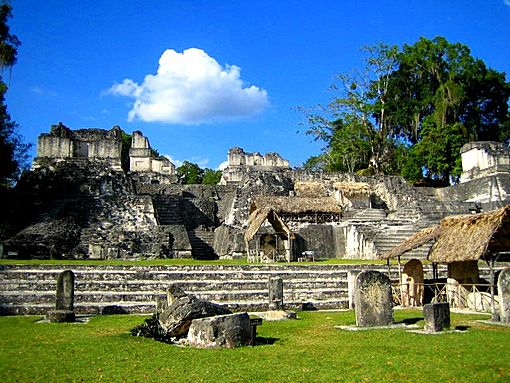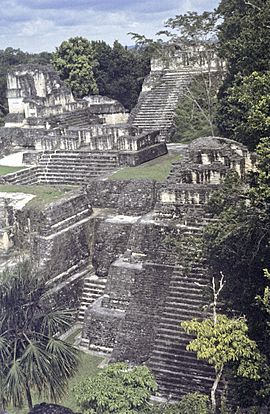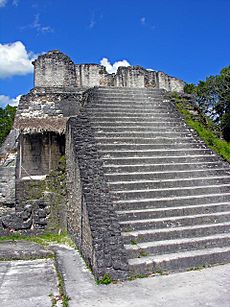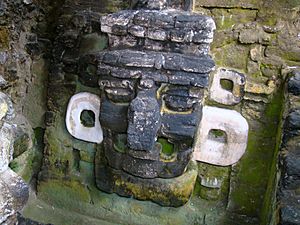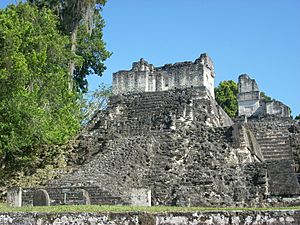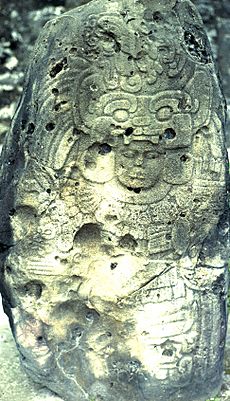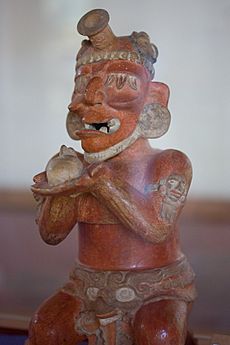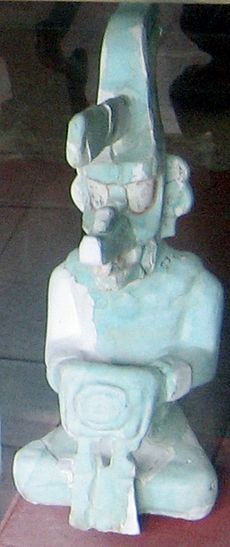North Acropolis, Tikal facts for kids
The North Acropolis is a very old and important part of the ancient Maya city of Tikal. Tikal is located in Guatemala. This area was like a special royal cemetery and a place for funerals for over 1300 years. It is found right in the middle of Tikal. Many experts have studied this Maya building complex. Teams from the University of Pennsylvania dug here from 1957 to 1969.
People first started living here around 800 BCE. The first buildings were put up about 350 BCE. Around 250 CE, the area was greatly changed. A huge platform was built to hold many temples. Later, around 450 CE, four pyramids were added. These were on a terrace south of the main platform.
Archaeologists have found several royal tombs here. These tombs belonged to famous kings. Some kings found here include Yax Nuun Ayiin I (ruled 379 CE – c. 404) and Siyaj Chan K'awiil II (ruled 411–456). Other kings were Wak Chan K'awiil (ruled 537–562) and "Animal Skull" (ruled c. 593–638). An early tomb might even belong to the first king of Tikal, Yax Ehb' Xook (ruled c. 90).
Many stone monuments were placed in the North Acropolis. By the 9th century CE, there were 43 tall stone slabs called stelae. There were also 30 altars. Eighteen of these monuments had hieroglyphic texts and pictures of kings carved on them. Some of these carvings show ideas from the great city of Teotihuacan in the Valley of Mexico.
Contents
Building the North Acropolis
The very first signs of people working here are from about 800 BCE. They cut deep into the limestone rock. The first buildings in the North Acropolis were built around 350 BCE. This was near the end of the Middle Preclassic period (c. 1000–300 BCE).
Early Maya Times
During the Late Preclassic period (c. 300 BCE – 250 CE), a wide stone road was built. This road was about 49 meters (160 feet) wide. It connected the North Acropolis to the Mundo Perdido area. The oldest buildings here were from the 2nd century BCE. They included a low platform to the north. Two smaller platforms were to the south. These later became Temples 22, 23, and 24.
In the 1st century CE, the North Acropolis grew a lot. It slowly became the main religious center of Tikal. Before this, the Mundo Perdido complex was more important. The North Acropolis also started to be used for royal burials.
Classic Period Changes
During the Classic period (c. 250–900 CE), Tikal's kings made the North Acropolis their royal burial ground. Each new ruler built new temples over older ones. Around 250 CE, old buildings were removed. A new main platform was built. It held four buildings with special arched roofs. Around 400 CE, the complex grew south. A row of tall pyramids was added. These pyramids separated the original buildings from Tikal's main plaza.
Later, around the end of the 7th century, King Jasaw Chan K'awiil I ordered a new Temple 33 to be built. This temple might have held his father's remains. This new building blocked the main entrance to the North Acropolis. This meant it was no longer the main burial place for Tikal's kings. Around 734 CE, King Jasaw Chan K'awiil was buried in Temple I. This temple is on the east side of the plaza. This ended the tradition of burying kings inside the North Acropolis.
Later Times
People still used the North Acropolis for burials even in the Postclassic period (c. 900–1525). As Tikal became less populated, people searched the North Acropolis. They looked for valuable jade items in the royal tombs. Some easy-to-find tombs were robbed during the 10th or 11th centuries.
Important Buildings
The North Acropolis forms the northern edge of the Great Plaza. Its main platform is almost 1 hectare (2.5 acres) in size. It measures about 100 by 80 meters (328 by 262 feet). The platform stands 9 meters (30 feet) above its rock base. It is 12 meters (39 feet) above the Great Plaza. You can reach it by several stairways on its south side.
In earlier times, many temple fronts had bright stucco decorations. These included huge masks next to the stairways. By the Early Classic period, eight temple-pyramids stood on the platform. Each had a stairway with masks, a small shrine at the top, and a fancy roof decoration.
Main Platform Structures
Most buildings on the main platform were built in two stages during the Early Classic period. Temple 22 had three building stages. All these buildings are from the Early Classic period. They were arranged symmetrically over three centuries. This area has the most Early Classic buildings in Tikal. Their building style is different from the later temples around the Great Plaza.
Temple 22 (Structure 5D-22) faces south. It is in the center of the north side of the platform. This temple had three main building stages. The first version was built around 250 CE. A second version was built over it around 350 CE. This one had huge stucco masks. The final version is from the 5th century CE. Archaeologists have studied Temple 22 a lot. They removed parts of the 5th-century building to see the older ones. A tomb in Temple 22 was robbed sometime in the Postclassic period.
Temple 26 (Structure 5D-26) is the main building in the North Acropolis. It is in the center of the south side of the platform. It looks out over the terrace. The earliest version of this building is from about 250 CE. Temple 26 has been fully dug up and rebuilt. A tomb inside was robbed in the Postclassic period. The northern part of this building stood over an older tomb (Burial 85). This tomb is from around 100 CE. It might be the tomb of the first king, Yax Ehb' Xook.
Building 28 (Structure 5D-28) is an unusual building. It is at the top of a stairway on the east side of the platform. It seems to have been a guardroom. It controlled who could enter from the east terrace. The room had curtains and benches. The building blocked the stairway. This made visitors pass through the room. Here, they could be checked or stopped. This route might have become important after Temple 33 was built. Temple 33 blocked the main stairway from the Great Plaza. Structure 5D-28 was built late in the Early Classic period (around the 6th century).
Terrace Structures
A group of three small Early Classic temples (Temples 29 to 31) stand on a shared platform. They are at the east end of the terrace and face west. This platform was likely built to support these three temples at the same time.
Temple 32 (Structure 5D-32) is next to Temple 33. It was partly studied in the mid-1960s. It dates to the first half of the 7th century CE. The temple had three large rooms. These were robbed soon after Tikal was abandoned in the 10th century. Archaeologists found a royal tomb (Burial 195) cut into the rock under the pyramid. The pyramid was built over the tomb soon after the king was buried.
Temple 33 (Structure 5D-33) was a 33-meter (108-foot) tall pyramid. It was built for the 5th-century king Siyaj Chan K'awiil II. It was in the middle, between Temples 32 and 34. It faced the Great Plaza. This is one of the most studied temples in the Maya area. The temple was built in three stages over two centuries. The last stage was built during the Tikal Hiatus (562 to 692 CE). This final Temple 33 was a model for Temple I on the Great Plaza. Archaeologists took apart the last version of Temple 33 in 1965. This was done to reach the older parts underneath.
Temple 34 (Structure 5D-34) was the first pyramid built on the front terrace. It is from the Early Classic period. King Siyaj Chan K'awiil II built it over the tomb of his father, Yax Nuun Ayiin I. It had a shrine at the top with three rooms. Archaeologists dug a trench through Temple 34 in 1959. They found the tomb cut into the rock below. There were also two older versions of the temple built over it. Stela 26 once stood at the base of this temple. It broke, probably in the early Late Classic period. Its pieces were moved up the steps and placed under an altar in the shrine. The shrine was robbed in the Postclassic period. The altar was also broken then. People lit fires for sacrifices directly above Yax Nuun Ayiin's tomb. This continued into the Late Classic period. It shows they still honored the king centuries after his death.
Stone Monuments
Many stelae (tall carved stones) were put up in the North Acropolis. By the 9th century CE, there were 43 stelae and 30 altars. Eighteen of these had carved hieroglyphic texts and pictures of kings.
Stela 4 was put up by King Yax Nuun Ayiin I. It celebrated the end of a k'atun (a 20-year period) in 396 CE. It was placed at the base of his burial pyramid, Temple 34. The stela shows a mix of Maya and Teotihuacan styles. It has a picture of the king. He holds the Underworld Jaguar God and the Mexican Tlaloc god. His helmet looks like a Teotihuacan War Serpent. The king's face is shown from the front, which is unusual for Maya art but common in Teotihuacan.
Stela 31 is the top part of a monument. It broke and was buried above King Siyaj Chan K'awiil II's tomb in Temple 33. It was dedicated in 445 CE. It shows Siyaj Chan K'awiil II and his father Yax Nuun Ayiin I. Yax Nuun Ayiin I is shown as a Teotihuacan warrior on the sides. The back of the stela has a long text. It explains how Siyaj Chan K'awiil II's family had the right to rule.
Stela 40 was found at the base of Temple 29. It is from 468 CE. It shows the 5th-century king K'an Chitam. He holds a Teotihuacan-style headdress. The sides show his father, Siyaj Chan K'awill II, and his mother, Lady Ayiin. A long text on the back tells about his birth in 415. It also mentions him becoming a junior leader in 434 and king in 458. It briefly describes his father's rule too.
Royal Burials
Many important people, especially kings, were buried in the North Acropolis.
Burial 10 was the tomb of King Yax Nuun Ayiin I. He ruled in the late 4th century. The tomb is a large room carved into the rock under Temple 34. The king's body was placed on a wooden bed. Nine other bodies and a headless caiman (a type of crocodile) were with him. The tomb had many valuable items. These included many ceramic pots. Many were decorated with images linked to Teotihuacan. One drinking pot had writing that said, "the drinking vessel of the son of Spearthrower Owl." Five turtle shells were found. They were part of a musical instrument like a marimba. A small jade ornament shaped like a caiman's head was also found. The king's skull was dyed red. The caiman was important because part of the king's name, ayiin, means "crocodile." The animal might have been his way (spirit companion).
Burial 48 was carved from the rock under the terrace. It was directly under Temple 33. This tomb is believed to be for King Siyaj Chan K'awiil II. The king's body was placed between two young human sacrifices. One was a child, the other an older teenager. The tomb walls were covered in plaster. Hieroglyphs painted on them said the tomb was sealed in March 457 CE. This was a year after the king died. The king was buried sitting up, wrapped in cloth. His skull, hands, and thighbones were missing. The tomb had 27 ceramic pots, some local, some imported. There were also stone and shell items. A lot of jade items were found. These included jade discs and hundreds of beads that formed a necklace. Two obsidian blades were also with the burial.
Burial 85 is from the 1st century CE, in the Late Preclassic period. It was covered by a platform with a simple arched roof. This was the first royal burial that showed a shift in focus. The main ceremonial area moved from Mundo Perdido to the North Acropolis. The tomb was in the center of the North Acropolis. It was under what later became Temple 26. It held one male skeleton. The skull and thighbones were missing. Yax Ehb' Xook, the first king of Tikal, has been linked to this tomb. The person buried here likely died in battle. The bones were carefully wrapped in cloth to form an upright bundle. A small greenstone mask replaced the missing head. It had shell teeth and eyes. It also wore a royal headband. This head is a rare early Maya portrait of a king. Items in the tomb included a stingray spine, a spondylus shell, and 26 ceramic pots.
Burial 195 was a tomb with an arched roof. It was cut into the rock under Temple 32. This was the tomb of the ruler nicknamed "Animal Skull" by archaeologists. He ruled from the late 6th century CE to at least 628 CE. The king's body was wrapped in red-dyed cloth. The tomb flooded soon after it was sealed. A thick layer of mud dried and preserved the shapes of the king's offerings. This happened long after the wooden items had rotted away. Archaeologists filled these hollow shapes with plaster. This helped them rebuild many items that would have otherwise been lost. These included four large carved panels showing the king. There was also a small throne with hieroglyphs. A ballgame yoke and four stucco figures of the deity K'awiil were also found.
Burial 200 was the 6th-century tomb of King Wak Chan K'awiil. It was a stone tomb inside Temple 22.


